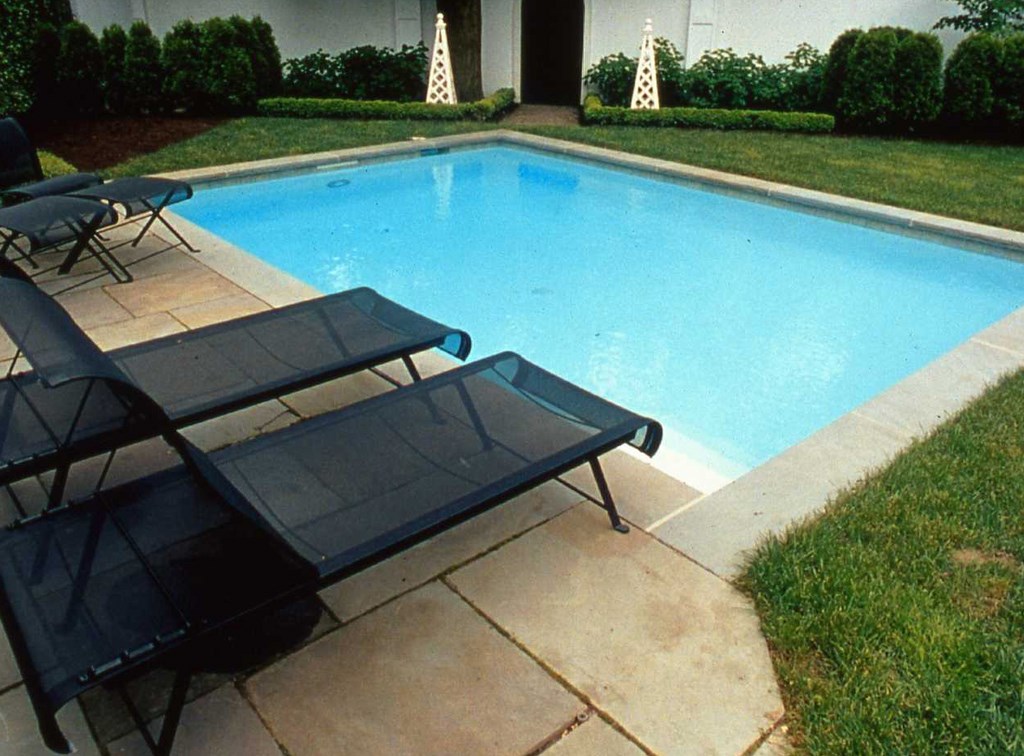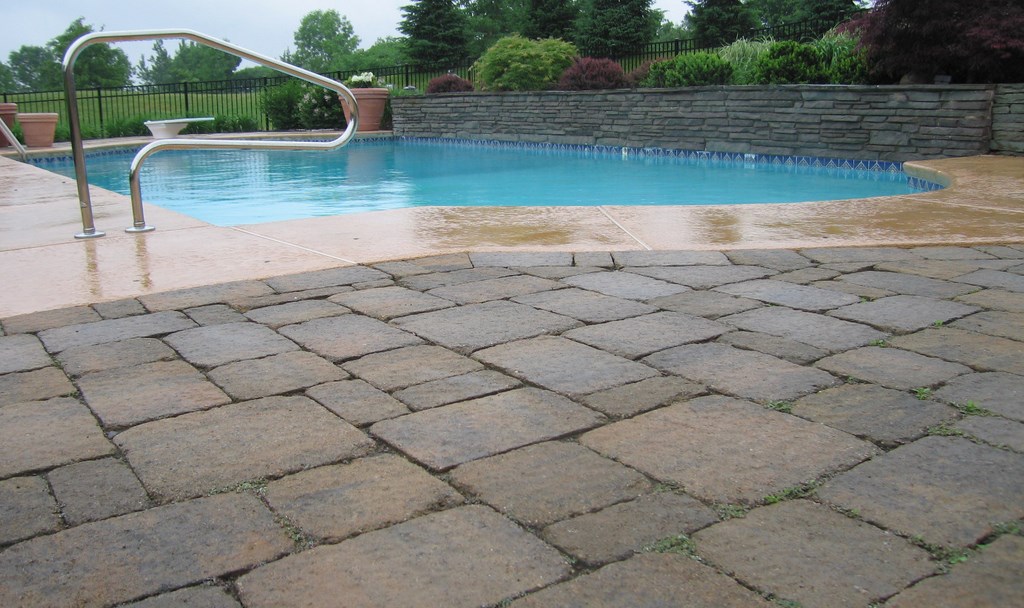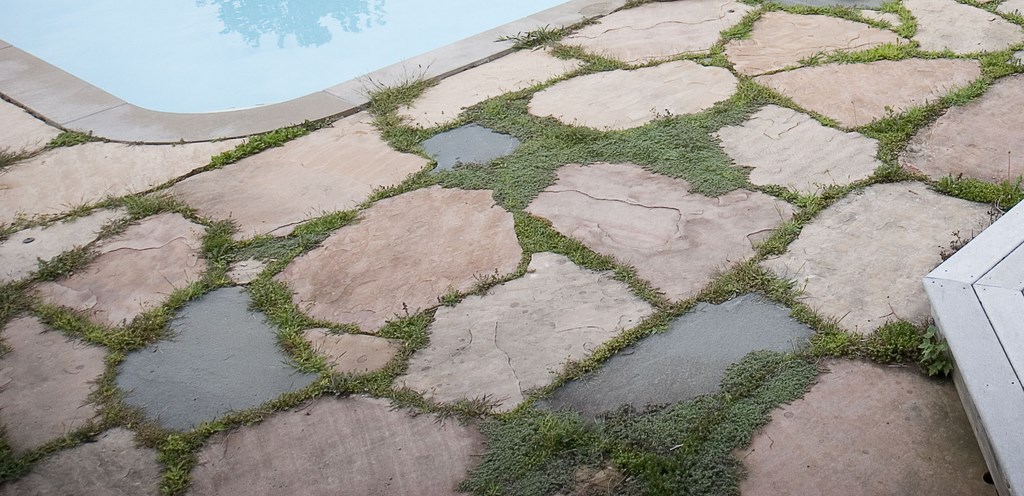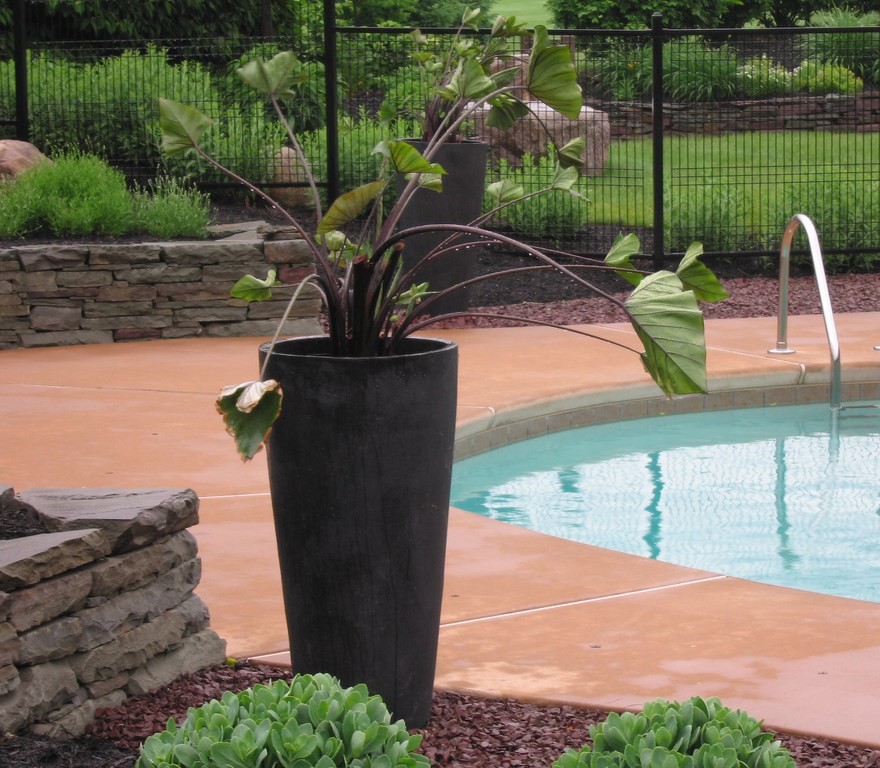Decked Out

Last month, I introduced my rundown on books I like to have at hand in my studio by mentioning a project that included a pool, an outdoor kitchen, stone walls, a fire pit and some other amenities. A feature I didn’t mention – but one that may well be unique for a backyard in upstate New York – was the Peruvian Travertine we chose for use around the pool.
While decking material seldom takes center stage in a design, its high visibility tends to make it more than just a bit player. Indeed, the choice of a material can either
bring an entire scene together by lending it a sense of comfort and interest, or it can take an otherwise functional and beautiful design and compromise its durability or aesthetics – or both.
As with most other landscape, hardscape and watershape choices, of course, the budget, clients’ desires, prevailing climatic conditions, color palettes and geology all influence the selection process – but even those constraints leave us with a broad range of decking choices these days. Some are standard and relatively common, but others are exotic and can become particular points of visual interest and even pride.
The key? Knowing your options and the materials’ performance characteristics while thinking about how your clients intend to use the space.
HOT AND COLD
The project that spurred this line of thought was among those that called for a beautiful deck to complement other stylish elements.
It took us months to make the final determination to go with the aforementioned Peruvian Travertine – a risky proposition given the weather extremes we endure in our area, but one we decided was worth taking because the absolute beauty of the product made it perfect for the setting and irresistible for the clients.
Truth be told, the climate around here is not quite as extreme as the occasional winter headlines would lead anyone to believe, but we do experience significant swings in temperature and weather in the course of a year, with summers reaching into the mid-90s on many occasions while winters sinking below freezing for long stretches.
Those seasonal changes can be a bear to endure, but they’re not what directly wreaks havoc on our work: What gets us is the constant freeze/thaw cycling, with temperatures climbing above freezing during the day turning anything exposed to moisture into something of a sponge. When this moisture freezes as temperatures drop again at night, expansion can break apart the host material.
Knowing the porosity of most Travertine types and not wanting to use the material only to watch it fall apart in years to come, I put this specific stone through a battery of tests, soaking it in water daily and putting it in my freezer overnight over the course of a few weeks. I also gathered information from the supplier about this particular stone’s absorption coefficient and its compressive strength – factors that are of utmost importance in choosing a product that will be exposed to our environmental extremes.
I saw this process of running the material through all of this testing as simple due diligence: So far as I knew, I was to be the first to use this Travertine outdoors in my area, and I wanted to be able to give my clients the assurance that it would all be worth it. After an exhaustive process, we decided to move forward – and the results are truly beautiful.
This is part of what a designer has to do in this or any other area to find new materials – products that not only get clients excited, but have the capability of doing so for the long haul. Whether you work in upstate New York or the desert Southwest or subtropical Florida, it pays to know your materials and choose them wisely.
That in mind, let’s run through a list of possible decking materials and point out some of the factors you should consider in determining whether those you’re considering are truly suitable for the job at hand.
Before we get to it, however, please consider one last point: In a watershaping context, it’s important to know not only how a material will perform over the long haul as a surface for a deck or patio or entryway, but also how it will stand up to the challenge of being consistently exposed to pool water and the salts and chemicals that come with it.
A SURFACING REGISTRY
Now let’s run through a list of possibilities, from artificial to natural:
[ ] Concrete: Relatively inexpensive and formable (and, in many cases, the only option considered), concrete has long been the most common paving material used around pools and for hardscape treatments.
Designers on the west coast have used this material to make aesthetic statements for decades (think Thomas Church and John Lautner, for example), but most of what I’ve seen in the east and in most other parts of the country is more utilitarian, probably because of the prevailing “that’s what we’ve always done” mindset. To this day, in fact, most installers see a three-foot apron of concrete around pools as the standard – which may be true of vinyl-liner pools if what their installers tell me is correct and the concrete ribbon is essential to the pool’s integrity.
That structural issue is fodder for another discussion, but once you get past that (literally) narrow perspective on concrete decking, it’s my observation that it’s an amazing material that, properly laid out and installed, can be a visual marvel.
Of course, that notion of proper layout and installation can be a stumbling block, and we don’t seem to be entirely past a time when we run into concrete surfaces spider-webbed with cracks or stamped in brick or stone patterns broken awkwardly by control joints – but the situation seems to be improving.
It takes some effort, but I’ll often have my mason cut control joints to follow a natural line in a stamped pattern – creating the look of two stones set next to each other, for example. Or we’ll used tan-colored aggregate to mimic the look of a sandy beach. We also exploit the possibilities of acid-staining, tile effects and slip-resistant finishes and are finding concrete to be more and more viable and valuable not only around pools but throughout our landscapes.
The key to using concrete is to establish an absolutely solid base and use lots and lots of reinforcement. After all, the worst thing that can happen to a beautiful concrete surface is to have it crack where you don’t want it to do so.
[ ] Concrete pavers: Perfectly suited to northern climates because of their ability to take a tremendous beating, concrete pavers have come a long way since their inception.
 Also known as interlocking pavers, the originals were shaped like keyholes or I-beams so that they would literally lock into one another, providing a solid, unmoving surface. Nowadays, of course, they come in many forms and can be obtained as products that resemble brick, stone or tile.
Also known as interlocking pavers, the originals were shaped like keyholes or I-beams so that they would literally lock into one another, providing a solid, unmoving surface. Nowadays, of course, they come in many forms and can be obtained as products that resemble brick, stone or tile.
The single biggest advantage of using these interlocking units is the fact that they can be removed for subsurface repair work or if they settle out of level. Thus, if you have a plumbing or lighting problem with a pool, you can simply pull up the decking, do the repairs and reset the pavers with far less effort than would be involved in jack-hammering away concrete or ripping up set stone or tile.
Another advantage of precast pavers is the fact that it doesn’t take much to learn how to install them properly. Most employees can be trained to do so in as little as a day, and even if they make a few mistakes, all you need to do is lift and reset the offending units. I have to say I haven’t been using them much in recent years, but I still call on them for the occasional driveway – and they even work well around pools because their surfaces not only look good but offer excellent traction even when wet.
[ ] Brick: Brick can work beautifully around pools, but there are a couple of reasons to consider this option with some care. For one thing, bricks can get very hot. For another, many bricks have relatively smooth surfaces and can be very slippery, especially when wet.
To get around that second issue, many manufacturers (including Belden Brick Co. of Canton, Ohio) make a sand-molded brick that has a rougher surface and the further advantage (depending on the project) of looking like it’s a hundred years old right after installation. But others, including the wire-cut bricks made by Pine Hall Brick of Winston-Salem, N.C., are smooth and may not be advisable around a pool.
Installation methods will vary, depending on where you work. In the southwest, for example, brick can be laid and mortared on a concrete slab. By contrast, in the northeast the same bricks will be laid on a bed of sand. (As with concrete pavers, this can be an advantage if repairs become necessary.)
To simplify installation, I suggest using bricks that are a true 2:1 (or 3:1) length-to-width ratio so there will be no gaps when you lay them out in herringbone or basket-weave patterns. If the brick supplier you’ve chosen isn’t consistent in dimensioning the product, you’ll inevitably have to deal with gaps that can compromise the visual pattern’s appeal.
[ ] Stone: Until fairly recently, Bluestone was fairly uncommon, even “exotic” beyond the northeast, but now it is regularly shipped to distributors in other places and has a distinct appeal to clients there who want something unique. Where I work, however, Bluestone is quite familiar and I’ve done countless installations using it as well as Flagstone. Indeed, these are without question my favorite products for lots of applications.
 I’ve used both around pools, but I do so only with due consideration. For one thing, both Flagstone and Bluestone are sedimentary sandstones that come out of the ground as sheets with relatively smooth surfaces that become quite slippery, particularly when wet. For another, Flagstone tends to come with imperfections – intense color veins, rust streaks, mineral deposits and more – that might not be ideal if your clients are after consistent appearances. (On the flip side, that varied appearance can make individual pieces of Flagstone into works of art that will highlight any project.)
I’ve used both around pools, but I do so only with due consideration. For one thing, both Flagstone and Bluestone are sedimentary sandstones that come out of the ground as sheets with relatively smooth surfaces that become quite slippery, particularly when wet. For another, Flagstone tends to come with imperfections – intense color veins, rust streaks, mineral deposits and more – that might not be ideal if your clients are after consistent appearances. (On the flip side, that varied appearance can make individual pieces of Flagstone into works of art that will highlight any project.)
In addition, heat can be an issue with Bluestone and the darker Flagstones. The dark colors absorb the sun’s heat and can make them literally unpassable by bare feet, which is one of the reasons I rarely place them around pools.
Flagstone presents another issue: The material is typically shipped in random-sized sheets called “broken Flagstone,” and the edges of those sheets can be razor-sharp. Years ago, I tried my utmost to talk one set of clients out of using broken Flagstone around their new pool. They insisted, so one of my foremen spent two very full days hitting every edge with a four-inch hand grinder for an expanse of more than 1,300 square feet of deck.
To be absolutely certain there would be only minimal opportunities for problems, we also planted hundreds of creeping plants (including thyme and sedum) in the joints. Today, the site is a beautiful vignette of stone, water and plants – but it took lots of doing to make it so with safety.
[ ] Travertine: This wonderful material comes in many incarnations and a seemingly endless array of subtle colors. Although my direct experience is limited to the Peruvian product mentioned above, now that I’ve used it on two projects and have had the chance to observe its performance through a recent winter with more than 50 freeze/thaw events, I’m convince of its viability in this climate.
One issue I had with the material is that it came with many pieces that had deep depressions and sharp edges we had to work our way around. Nonetheless, the beauty of the material is unsurpassed, with swirls of color and unique splotches making each piece a work of art.
Ultimately, however, beauty wasn’t the only factor that won me over: First, the material’s coefficient of friction actually increases when it’s wet, which makes it ideal for watershape environments. Second, it has a compressive strength beyond 17,000 psi – almost double that of Pine Hall’s wire-cut brick and more than double that of the strongest concrete pavers. Finally – and a detail of great importance where I live – its coefficient of absorption was less than that of any product I have used.
These facts, coupled with the absolute beauty of the stone, convinced me to go ahead with it around one pool and for the entryway of another project. These weren’t decisions taken lightly: The cost in the case of the pool paving was close to $30,000, but it has proved to be the right move.
[ ] Wood: While used mainly around aboveground pools and spas for reasons of economy (after all, raising a stone terrace up to pool’s level could prove to be quite expensive), I’ve also seen wood used very effectively around ground-level pools.
In the best cases, it creates a distinctive boardwalk effect – powerful imagery for clients who spent time as children walking the boardwalks at various east-coast beaches and swimming in the ocean.
The biggest enemy of wood, of course, is constant wet/dry cycling, which makes it imperative to seal wood thoroughly around watershapes. As alternatives to standard decking materials such as Redwood or Cedar, you might also look into the availability of Ipé (an exotic hardwood) or even composite products.
[ ] Grass: Who says you need paving at all when you can have grass come all the way up to the back of the coping or even to the edge of the pool? I personally like the idea of “softscaping” around pools, but that’s sometimes tough to get across to clients and contractors in our region who’ve been trained to expect or deliver three feet of coping and concrete with every pool.
GOING FOR IT
The list above is far from comprehensive – I’ve left out the entire world of tile options, for example – but it’s a solid, practical start. I can’t leave this discussion, however, without mentioning the special challenges that come when the area around a watershape is intended to follow a path dictated by Mother Nature.
As I write this, in fact, we’re working with on a pool that will look as much like a pond as we can manage. So far, I’ve set about 40 tons of boulders and slabs around the pool (not as a ring of stone, mind you) to create a creek/waterfall system that flows into the pool. The remainder of the space will be planted to blur the pool’s edge and create visual transitions that will make the client’s vinyl-liner pool seem as natural as can be.
I’ll share that project with you when we’re all done. In the meantime, look into this list and all of the additional options available to you where you live and find some joy in the richness of the palette we have to work with as watershapers: There are amazing possibilities out there for those who think things through and know how various options will perform in clients’ backyards.
Bruce Zaretsky is president of Zaretsky and Associates, a landscape design/construction/consultation company in Rochester, N.Y. Nationally recognized for creative and inspiring residential landscapes, he also works with healthcare facilities, nursing homes and local municipalities in conceiving and installing healing and meditation gardens. You can reach him at [email protected].












